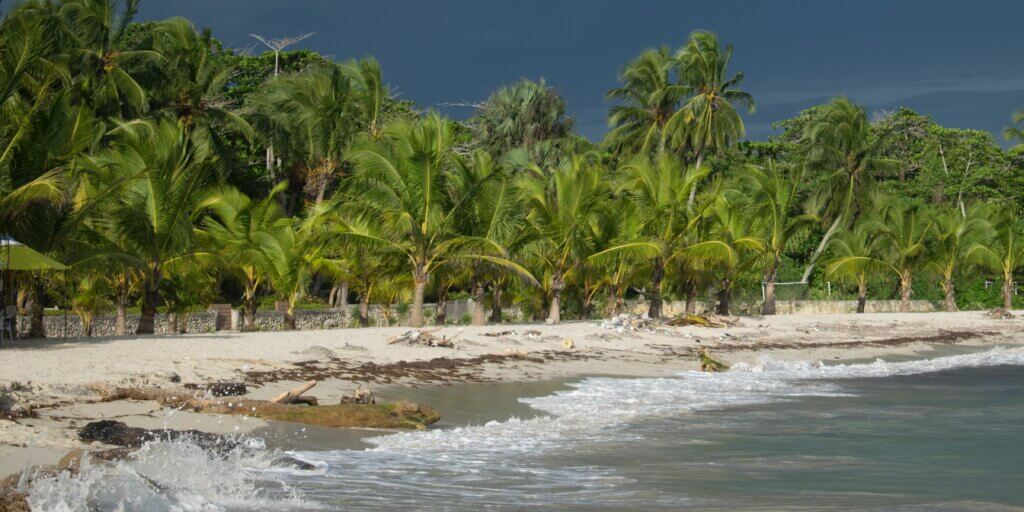
In 2016, former President of Palau, Tommy E. Remengesau Jr., in his address during the annual congress of the international Union for Sonservation of nature (IUCN), reestablished his country as a “Large Ocean State” rather than a small island state.
With this proclamation, he emphasized island nations’ sovereignty over huge swathes of the world’s oceans. Despite their comparatively small landmass, Large Ocean States possess significant economically and geographically important territory. However, according to the UN, in the case of Small Island Developing States (SIDS), their Exclusive Economic Zones (EEZs) cover about 30% of all the blue on our planet: oceans and seas.
For Dr. Ma. Jamero, this terminology becomes especially important in the context of climate change, “in the news, most narrative surrounding small islands is related to sinking, disappearing, or that they might be erased in a few years.” As an islander herself, she finds it frustrating, but more importantly, she has noted that this framing can have a substantial impact on funding and international support.
“It is quite dangerous to portray small islands in that way because we become basket cases whose only option is to migrate.” However, the migration of an entire country’s population comes with its own set of challenges: social and economic, cultural and political. With an already vulnerable population, climate adaptation and mitigation come with unique complications.
As a survivor of Super Typhoon Odette in 2021, Dr. Ma. Laurice Jamero has a unique perspective on climate science.
She clarified that, the biggest concern for people was not the next typhoon, but rather where to find food, how to get water, what to do with all the schools closed, how to take care of others with health issues…” In the most vulnerable contexts, like in the aftermath of a climate disaster, people’s concern is not really climate related but rather development related.”
Due to her personal understanding of the complexities of climate adaptation, Dr. Jamero expresses this in all her work. She finds that often island-focused climate research and policies are becoming less solution oriented and encourage migration rather than adaptation. In her view, climate change needs to be framed as a development issue; solutions for population vulnerability need to be simultaneous with a pressing climate agenda.
Beyond SIDS, vulnerability extends to small islands globally, including small islands underrepresented within the country they are a part of.
The concept of vulnerability has multiple components in the case of climate change: financial, technological, institutional, economic and social adaptation. Dr. Jamero emphasizes the importance of moving past nations to focusing on populations; climate issues apply to all islands, not just SIDS.
In the case of the Philippines, an archipelago composed of some 7,640 islands, many islands are underrepresented at the national level according to Dr. Jamero, with small islands representing only a few of the Philippines’s barangays, its smallest units of government. Islands that that are part of larger countries can struggle with representation as they are not covered by SIDS nor within their own countries.
The vulnerability of such islands is only exacerbated when considering social and economic situations. For example, farming or fishing communities can be very dependent on their ecosystems for their livelihood as there is limited diversification of income. When these populations are hit by extreme climate events, inequalities are increased in the local community and the wider global community due to the limited diversification of income.
As a climate scientist, Dr. Jamero sees the importance of indigenous and local knowledge daily. She finds that risk assessment is predominantly driven by experts in a top-down manner, focusing primarily on hazards due to the availability of relevant data. This approach tends to overlook the different vulnerabilities of the communities and end-users. She calls for research to address populations vulnerability, rather than solely concentrating on hazards and exposure.
Dr. Jamero has specifically observed this phenomenon in the context of early warning systems. While actively monitoring Super Typhoon Odette, in 2021, she noted it was a Category 2 before bedtime. To her surprise, she was abruptly awakened by her colleagues to inform her it had reached Category 5—the highest category with the most powerful winds.
None of the forecasts had captured it. Ma. Jamero attributes this to the limitations of early warning systems, which were entirely forecast-based, and thus have many limitations in what they are able to detect: in this case, the rapid intensification of the typhoon.
She sees the lack of incorporation of traditional knowledge systems—knowledge of winds, when the eye of the storm is overhead, and when the storm is passing—as a missed opportunity with life-and-death consequences. With such pressure on the science, she wants more space for indigenous knowledge, especially for early warning systems.
For islanders, precarious environmental situations have already been an issue. In Dr. Jamero’s case, she notes that super typhoons, despite being exacerbated due to climate change, are not new.
She recommends following the lead of island countries and to shine the adaptive policies of Large Ocean States. The challenges posed by climate change extend beyond the realm of scientific research and require collaboration both at the institutional and individual levels. This approach encompasses fostering communication between data producers, such as scientists, and data users, including city planners, policymakers, and the general public.
With climate change resulting in both rapid onset events like typhoons as well as slow onset events like sea level rise, dialogues need to occur between practitioners to implement solutions that work for communities. Dr. Jamero actively contributes to this collaborative effort through her part in the PEERS (Practioner Exchange for Effective Response to Sea Level Rise) Global Development Committee which works on bringing together practitioners to support communities from these events.
Dr. Jamero cautions against condoning the islands to inundation when she sees a lot of adaptation potential. Instead of seeing climate adaption as a hopeless endeavour, she sees this history as proof of the islanders’ capacity to adapt. In her experience as a super typhoon survivor, she noticed that even after such a traumatic event, people still wanted to keep their homes.

Dr. Ma. Laurice Jamero
Dr. Ma. Laurice Jamero is the Coordinator of the Resilience Collaboratory at the Manila Observatory, spearheading science-to-impact initiatives on communicating and mainstreaming climate science into development planning.
“My training is in sustainability science, so I prefer to pursue socially relevant research. For someone from my background, climate change is a lived experience. [It] is not something that we just read from a journal paper or hear from the lectures – and as such, climate change needs to be framed as a development issue.”

Global solidarity for climate justice: perspectives from an early-career researcher
In this article, Dr. Leandro Diaz, a climatologist from Argentina, shares his perspective on global solidarity for climate justice.

The human dimension of disaster risk reduction: social sciences and climate adaptation
In this article, Dr. Roché Mahon, a social scientist specialized on climate, highlights how social sciences can effectively improve climate adaptation and ultimately save lives.

Fostering tomorrow’s science: the ISC’s engagements with Early and Mid-Career Researchers in 2023
To mark the launch of its newsletter dedicated to updates and opportunities for Early and Mid-Career Researchers (EMCR), the International Science Council reflects on a year rich in engagements with the next generations of scientists.
Photo by McKay Savage on Flickr.
Disclaimer
The information, opinions and recommendations presented in this article are those of the individual contributor/s, and do not necessarily reflect the values and beliefs of the International Science Council.